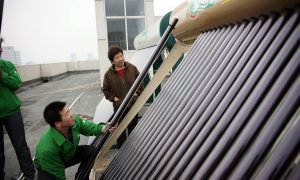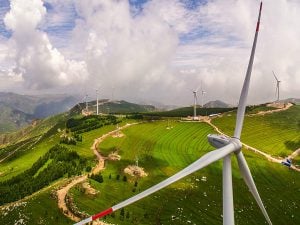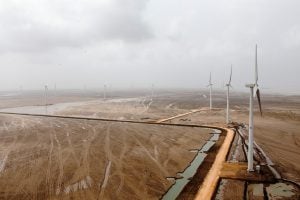The 382,000 residents are some of the poorest in the country, living below the poverty line of 2,300 yuan (about US$1 per day). This was the key criteria for their selection in the project, which is part of China’s 13th Five-Year-Plan, the roadmap for the nation’s development from 2016 to 2020.
In 2015, President Xi Jinping announced the Chinese government would eradicate poverty in China by 2020, which requires targeting the country’s 70 million people living below the poverty line. In April, 2015, China’s National Energy Administration released a plan to use solar photovoltaics (PV) to increase the income of 2 million Chinese households within 16 provinces and 471 counties.
The project is being piloted in Yuexi county, Anhui province before being rolled out across the country. Villagers identified as living below the poverty line will have rooftop solar panels rated at 3-5 kilowatts installed on their roofs and become shareholders in village solar power stations with a generating capacity of around 60-100 kilowatts. The aim is for the solar panels to earn each family 3,000 yuan (around US$430) in extra income each year. Local farmers could also earn additional income by leasing out non-arable lands or maintaining the solar farms.
So far, 182 villages (with 30,000 residents) in the county have been identified as eligible for the project. Construction has begun at a staggering pace: 57 solar parks were built in 2015, with the remaining 125 expected to be finished this year.
Unlike many other developing countries, around 99% of all Chinese households already have access to the grid.
Each household will use the solar electricity generated for their own purposes. This will reduce energy bills and any surplus electricity will be sold back to the grid. Families will also have shared ownership of the solar parks, splitting 40% of the profits between them, with the remaining 60% going to pay back loans and park construction fees. This means that once the solar panels are installed, households and villagers could begin to see the benefits quickly.
“It will take more time before we know the impact of the project,” warned Yixiong Kang from China Carbon Futures Asset Management Company, which is overseeing the financial and technical aspects of the project.
“But it could have a huge impact. We are talking about the poorest families. They basically have nothing in their houses that use electricity [because they can’t afford to pay the bills].” The extra income they’ll earn could change that. “If you want to change the living standards of people, sometimes it’s not enough to just give them electricity. Electricity – that’s just a power supply. They need greater help,” he added.
Aside from the direct profits, the villagers would also likely benefit from subsidies paid to solar generation projects in China. The rates are set to go down in 2017 due to a solar power generation surplus, but, if paid, will also help increase the villagers’ profits. The village level solar stations will also be part of a Chinese emissions trading programme which is currently being established. The village solar stations that have certified emissions reductions certificates could trade 1000 kWh of their clean energy to replace one tonne of carbon dioxide emissions on the carbon trading scheme.
When China’s national cap-and-trade programme officially launches in 2017 its carbon trading market will be the largest in the world. The sums set to be generated are substantial. By the end of October 2015, China had seven pilot carbon trading markets in seven cities and provinces. The total emissions ‘allowances’ distributed during 2015, said Kang, was the equivalent of 1.2 billion tonnes of carbon dioxide, with a projected turnover of 1.3 billion yuan (around US$188 million).
Of course, this is all still very much at the pilot stage. The village solar power stations are still being built and it’s not yet known how much electricity from the stations could be sold. But clearly the scheme could generate a substantial income for people surviving on less than a dollar a day.
China: World leader in solar
China is the world’s biggest generator of solar power, surpassing even Germany with its 43.2 gigawatts of solar capacity in 2015. China’s 13th Five-Year-Plan aims to rapidly increase its solar capacity, adding 15-20 gigawatts each year. Despite this huge solar generation capacity, China has a small domestic market to absorb it, which the government is eager to remedy. It introduced its own solar subsidy programmes between 2010 and 2011 but they haven’t been successful. “Distributed solar targets are the only ones that haven’t been met yet,” said Wei Shen, a research fellow at the Institute for Development Studies. “It is very rare for China – once you have a political target, it’s always met.”
Domestic PV installations have been low due to a number of factors, including difficulties connecting the solar PV energy supply with the electricity grid, city dwellers’ lack of easy access to roof space in their high-rise apartments, and high costs. The NEA’s solar poverty alleviation plan could help create domestic markets to absorb some of China’s total manufacturing solar PV capacity.
But the project faces considerable obstacles. The first is finance. According to Kang, each 60 kilowatt village power station costs 480,000 yuan (around US$70,000) to build. A three kilowatt household solar system costs around 24,000 yuan (about US$3,500). The plan seems reasonable on paper until you consider the scale of the project. Those costs add up to a staggering bill of around 30 billion yuan (US$4.5 billion) over the next five years. Where will the money come from given that banks are reluctant to provide loans to solar projects?
The project’s short-term timescale also poses a challenge to its long-term sustainability. “There is a gap between the short-term targets and the long-term vision. It’s not just about up front financing, but about securing long-term financing to make this work for 10 or 20 years,” said Shen. “But that’s not in the time frame for local officers – they want this political campaign to be done in two or five years. It’s a swift marriage. But how to keep the marriage long and happy?”
Technical challenges
In many places the infrastructure for sending power to the national grid is not in place, which poses a serious technical challenge. Villagers and counties also have little negotiating power with monopolistic grid companies.
Solar panels need to be serviced too. The construction companies contracted to build the solar parks will be responsible for the maintenance of the solar panels during the first five years, said Kang, but he admitted that they were still “working on the details” and applying for the budgets for the solar panel maintenance from the provincial government. After five years, the county governments aim to “commercialise the contracts”, leaving families to pay if the panels develop faults, said Kang.
“Once you have all these millions of panels installed on people’s rooftops, will that be the end of this political campaign?” asks Shen. “Who will fix and maintain them if some of them are broken or not connected to the grid? There are a lot of implementation gaps.” As this short film about the afterlife of solar technology in the Indian state of Odisha shows, if these gaps aren’t addressed and the solar technology breaks down, no one benefits.
Social enterprises and non-governmental organisations could help resolve the problems. They have proven successful in introducing distributed solar in East Africa, for example. But in China, meddling social organisations aren’t generally welcomed by local governments.
Shen believes these challenges could hamper the project’s success. “There are a lot of questions that haven’t been answered. Until they are, investors won’t get too serious about this project.”
Despite the obstacles, the project is backed by the central government, which should give hope to poor villagers that are looking to benefit from the scheme. “In China if the central government want you to work this out then there will be no huge obstacles – since the central government is very powerful,” said Kang. “But it still takes time.”





